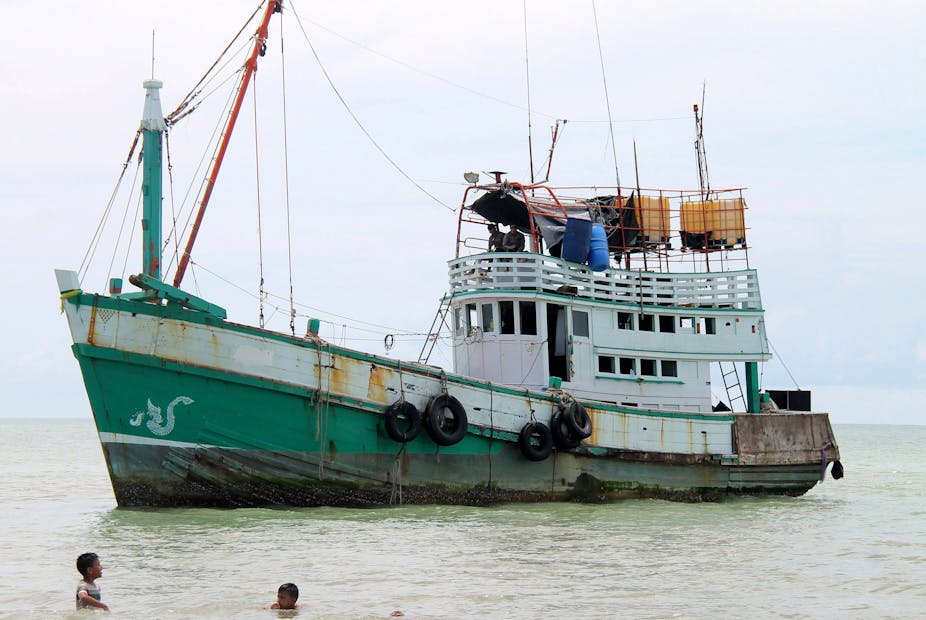In recent days, some 2000 refugees and migrants from Bangladesh and Myanmar have come ashore in Aceh, Indonesia, and Langkawi, across the Strait of Malacca in Malaysia. Thousands more are feared stranded on the high seas.
A maritime crisis has been brewing in the waters of the Bay of Bengal for some years now, but it was rarely reported. All eyes have been on the “boat people” arriving on Australia’s doorstep and more recently on those making it to Europe across the Mediterranean.
Why are people risking their lives at sea?
What is driving these people to pay what are, for them, astronomical fees for passage on often unseaworthy vessels?
Several push – and pull – factors are at play for different groups making the treacherous journey across the sea from Bangladesh to Thailand. The two largest groups at sea presently are Bangladeshis as well as Rohingya from Myanmar.
For the former group, economic reasons prevail with the promise of better-paid work in places like Malaysia. There, migrants, legal and illegal, can make sufficient money to send remittances back home, thus sustaining themselves and their families. This is the hope despite the reality of working one or more jobs in at times hazardous circumstances being quite different. Yet they keep coming in search of a better life for themselves and their families.
For Rohingya, the situation is more complex. There has been a steady stream of irregular migration from their homelands in Myanmar via Bangladesh to Malaysia for more than 20 years. Most Rohingya in Myanmar are considered “resident foreigners” since a 1982 citizenship law effectively made them stateless and left them without recourse to attain citizenship in Myanmar.
The effects have been all-encompassing for Rohingya. They have had their freedom of movement contained, access to education severed, property confiscated and conscripted into forced labour.
In addition sporadic violence, such as the 2012 riots in Rakhine state, further displaced tens of thousands of Rohingya and led to more fleeing across the border to Bangladesh. There, over 30,000 refugees live in refugee camps while 200,000-500,000 remain undocumented, according to the UNHCR.
With few opportunities to resettle and/or earn a living, many are attracted to Malaysia, which is seen as a middle-income country awash with opportunity. In addition, Malaysia is perceived to be Muslim in character and many Rohingya are disappointed by the lack of support from their co-religionists there.
The sea journey from Bangladesh to Thailand and the onward overland trek through the jungle to Malaysia has been a popular and affordable way for many Rohingya to make it to protection space that has given most a way to survive and some the means to prosper. I recently talked to a family who arrived in Malaysia with nothing only a few years ago. Today they run a neighbourhood grocery store and are able to send all their children to a school, albeit a refugee school that does not offer certificates.
Even mundane normality is a gift and blessing for them and countless others who are ready to make that journey on a boat in the hope of a better future.
Flow of boats is increasing
Human trafficking and people’s irregular movement across the sea from Bangladesh and Myanmar to Thailand have picked up pace as the situation in Myanmar becomes more precarious for Rohingya people especially.

They crowd into the boats and endure long times at sea and in jungle camps along the Thai-Malaysia border. These have made headlines recently for the horrors of slave labour, extortion and death.
Refugees I have interviewed in Malaysia told me of the cramped and desolate conditions on the boats ferrying them across the Bay of Bengal. One Rohingya refugee spent three weeks on the boat.
They were kept inside the hull of the boat so as not to draw attention to the boat masquerading as a fishing trawler. They were given minimal provisions of food and had to drink seawater for most of the journey. The traffickers had told them they did not want the boat to get messy – i.e. inundated with people’s waste – but at the same time they restricted access to the deck area.
The hardest thing, many told me, was not knowing where they were or what was going to happen next.
Lives depend on a regional solution
The International Organisation for Migration (IOM) has appealed to Southeast Asian governments to assist refugees and migrants still at sea and rescue them. The governments of Indonesia, Malaysia and Thailand have remained silent on their rescue efforts.
In the Bay of Bengal there have been many reports of push-backs and tow-backs, especially by the Thai navy. One report even claimed the Thai navy shot at Rohingyas arriving by boat. These crude attempts to stem the flow of boats have been unsuccessful.
At the heart of the issue remains the Myanmar government’s approach to minorities in its country. It is by far the largest contributor to refugee flows in the region.
ASEAN and the regional powers, including Australia and the United States, have to take on a more vocal role to secure the rights of displaced people and work together towards a regional solution. A one-day special meeting set for May 29 in Thailand is a good first step. Myanmar is opening up and reforming, but without proper recognition of its minorities and a durable solution to hundreds of thousands of displaced people from Myanmar the boats will keep coming.

